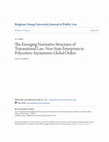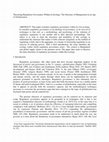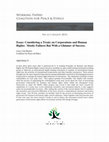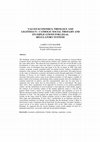Papers by Larry Catá Backer

Corporate Law: Corporate & Financial Law: Interdisciplinary Approaches eJournal, 2008
It is well known that soft international law has begun to provide incentives for the management o... more It is well known that soft international law has begun to provide incentives for the management of a values-based behavior structure for multinational corporations. This paper will argue that hard international law can serve as a vehicle for the enhancement of a market environment in which corporate stakeholders, and principally consumers and investors, might incorporate information about corporate social behavior in their consumption and investment decisions. Specifically, a mandatory system of transparency and disclosure at the international level may provide an efficient means of creating incentives for moral behavior without the need to incorporate any one version of appropriate manifestations of social responsibility on corporate entities. International law can thus institutionalize, within a rule of law context, important incentives for appropriate behavior without incorporating any particular set of public values and provide a legal framework through which stakeholders can ma...
This post was contribute by Larry Cata Backer, W. Richard and Mary Eshelman Faculty Scholar Profe... more This post was contribute by Larry Cata Backer, W. Richard and Mary Eshelman Faculty Scholar Professor of Law and International Affairs at Pennsylvania State University. The 2015 United Nations Forum on Business and Human Rights will focus on “Tracking Progress and Ensuring Coherence.” The business and human rights stakeholders are increasingly focused on taking the measure of that project. An influential stakeholder, Measuring Business & Human Rights, launched a blog series on how to assess and track implementation of the UNGP.

SSRN Electronic Journal, 2020
This essay considers the emergence of data driven analytics and the algorithmic techniques of imp... more This essay considers the emergence of data driven analytics and the algorithmic techniques of imposing consequences (some of it machine driven (artificial intelligence (AI) based) as defining not just new modalities of governance but reshaping the conception of spatiality within which entangled governance happens. So reshaped, these data driven governance legalities entangle with traditional modes of governance through law in what may be new and interesting ways. At its center is an examination of governance entanglement between the entangled legalities of law-norm systems and the legalities emerging from data driven systems of behavior management. The entanglement becomes more confused where one set of systems (law/regulation) continues to posit that metrics based governance is merely technique, rather than a regulatory system in its own right. The realities of emerging legalities that exceed the capacity of law to express their form requires a three dimensional analysis of entanglement and a broader view of legality, one that reconsiders data driven machine administered regulatory systems more than an enhanced form of property. The first section briefly sketches the characteristics of emerging legalities that neither embrace the form nor the language of law. The two sections that then follow examine the nature of inter-systemic entanglements when data driven governance legal orders are thrown into the already plural mix of legalities. The first is the Chinese “social credit” initiative. The second is U.S. and Western private initiatives around emerging markets for data. Each exhibits quite distinct characteristics and therefore quite different forms and qualities of entanglement that suggest a more complex fracture and inter acting among ever more different systems of legalities that are emerging in fractured political systems arranged around global trade regimes.

SSRN Electronic Journal, 2017
The 19th Congress of the Chinese Communist Party concluded at the end of October 2017. It set the... more The 19th Congress of the Chinese Communist Party concluded at the end of October 2017. It set the fundamental policy positions of China’s leadership for the next five years with particular emphasis on its approaches to constitutionalism, law, and the political theory of the state. These internal political changes will have substantial effects on China’s external relations and on the ways in which Western liberal democracies engage with China. In that context among the most important questions for law revolve around the extent and character of the evolution of CPC thinking, and the CPC Basic Line, with respect to Socialist Rule of Law and Socialist Constitutionalism. The question arose in the context of a key document of the Congress, the Work Report delivered by Xi Jinping reflected in the resulting final Resolution of the 19th Congress. To what extent did this report reflect an official downshifting of the importance of the state constitution and constitutionalism within the construction of Chinese notions of Constitutionalism, and if so, what variation on constitutionalism is likely to emerge? As interesting was a follow up question around the effects of any such downshift on the relation between the state and the political constitutions of China. To that end, it is worth considering whether principles of constitutionalism for the “New Era” may be extracted from Xi Jngping’s Report to the 19th Congress. And if they can, to try to extract a sense of the likely characteristics of emerging structures of Chinese constitutionalism. What follows, then is a preliminary report and assessment of Constitutionalism with Chinese Characteristics in the New Era from Out of the 19th CPC Report. It is organized in five sections, (1) a brief introduction to the issues and context of Chinese constitutionalism before the 19th Congress, (2) a consideration of the role of constitutionalism within the structures of the 19th CPC Congress Report, (3) a close reading of the specific references to constitutions in the Report (state, political and mixed), (4) a consideration of the connection between constitutionalism and the emerging characteristics of Chinese consultative democracy, and (5) brief concluding remarks.
SSRN Electronic Journal, 2017
a definition section covering thirty-three (33) terms. And indeed, in some respects the definitio... more a definition section covering thirty-three (33) terms. And indeed, in some respects the definitions are possibly the most important element of PNDES-providing the most concrete direction about the character of the implementation of the more generalized objectives set out in the rest of the document.

SSRN Electronic Journal, 2016
English Abstract: Two theories of Marxist state organization have been developing recently, each ... more English Abstract: Two theories of Marxist state organization have been developing recently, each pointing in quite distinct ways to the organization of society, the state, government and the role of the vanguard Party. The development of an Asian “Markets Marxism” Model is well understood. The recent emergence of a Latin American “Central Planning Marxism” Model is less well understood. This paper examines the characteristics of this emerging “Central Planning Marxism” mode by looking at its development in Cuba since 2011. The examination centers on the official theory produced from the 6th through the 7th Congresses of the Cuban Communist Party (PCC). The 7th PCC Congress stands in stark contrast to its predecessor. A close examination of the development from the 6th to the 7th Congress may suggest the limits of reform in Cuba. These limits are structural as well as ideological. After a short introduction, Part II considers the structural constraints on reform as evidenced in the 7th Congress. process aspects of the 7th PCC Congress. Part III then considers the ideological constraints on reform that were produced in the 7th Congress and its substantive consequences of what now appears to be a sputtering of the reform trajectory from the 6th to the 7th PCC Congress. That exploration revolves around a close reading of the major ideological product of the 7th Congress, its Conceptualizacion which is intended to complement the Guidelines (Lineamientos) of the 6th PCC Congress, and provide the theoretical foundation for its further implementation of the reforms these Guidelines represented. Part IV then contrasts this emerging Model with the Asian “Markets Marxism” Model. The consequences for political economy, legitimacy and law are also discussed. Differences between the Asian Markets Marxism and the Cuban Central Planning Marxist Models may have profound implications for rule of law development and the structures of regulatory governance in administrative structures. Those differences suggest the difficulty of developing consensus for key concepts in law — from rule of law, to human rights and markets. An understanding of these quite distinct conceptual frameworks of understanding law, economics and politics will be essential as the leaders of these quite conceptually distinct systems seek to interact.Spanish Abstract: Dos teorias de la organizacion marxista del estado se desarrollan en los ultimos anos, cada una apuntando en formas muy distintas a la organizacion de la sociedad, el estado, el gobierno y el papel del partido de vanguardia. El desarrollo de un modelo asiatico "marxismo mercador" se entiende bien. La reciente aparicion de un modelo latinoamericano "Central de Planificacion marxismo" es menos conocido. Este articulo examina las caracteristicas de esta modalidad emergente "marxismo planificador" al ver su desarrollo en Cuba desde 2011. Los centros de examen sobre la teoria oficial producido a partir de la 6a a traves de los 7o Congresos del Partido Comunista de Cuba (PCC). El 7o Congreso del PCC esta en marcado contraste con su predecesor. Un examen detallado de la evolucion del 6 al 7° Congreso puede sugerir los limites de la reforma en Cuba. Estos limites son estructurales, asi como ideologico. Tras una breve introduccion, la segunda parte considera las limitaciones estructurales de la reforma como se evidencia en el 7o Congreso. aspectos del proceso del 7o Congreso del PCC. En la Parte III se consideran las limitaciones ideologicas de la reforma que se produjeron en el 7o Congreso y sus consecuencias sustantivas de lo que ahora parece ser un chisporroteo de la trayectoria de la reforma del 6 al 7° Congreso. Esta exploracion gira alrededor del producto ideologico mas importante del 7o Congreso, su Conceptualizacion que esta destinada a complementar las lineamientos del 6o Congreso del PCC, y proporcionar la base teorica para su ulterior aplicacion de las reformas de las presentes directrices representadas. Parte IV contrasta este modelo emergente con el modelo asiatico "marxismo mercador". Tambien se discuten las consecuencias para la economia politica, la legitimidad y el derecho. Las diferencias entre la teorias marxista asiatico y latinoamericano tendran profundas implicaciones para el desarrollo del estado de derecho y las estructuras de gobernanza regulatoria en las estructuras administrativas. Estas diferencias sugieren la dificultad de desarrollar un consenso para los conceptos clave en el proceso legislativo del estado de derecho, los derechos humanos y de los mercados. La comprension de estos marcos conceptuales muy distintas de entender el derecho, la economia y la politica sera esencial, ya que los lideres de estos sistemas bastante conceptualmente distintas buscan interactuar.

SSRN Electronic Journal, 2016
In June 2014, an “open-ended intergovernmental working group to elaborate an international legall... more In June 2014, an “open-ended intergovernmental working group to elaborate an international legally binding instrument to regulate, in international human rights law, the activities of transnational corporations and other business enterprises” (IGWG) was established to overcome a number of purported deficiencies that some states and civil society actors had expressed about the soft law U.N. Guiding Principles for Business and Human Rights framework, endorsed by the Human Rights Council in 2011. Any move from regulatory systems grounded in Guiding Principles to one grounded in Treaty making raises two questions. The first is normative: what are the substantive goals of such a treaty. The second is operational: how should those goals be expressed in an international treaty? Both questions go to the fundamental ordering principles of regulatory construction and way such principles are developed and applied. After a short introduction, the essay first considers the great framework principles that might be extracted from the mandate for treaty elaboration of the IGWG. Those principles provide the objectives and substantive principles around which a comprehensive treaty will be elaborated. The essay then turns to the consideration of two levels of principles that may be used to guide pragmatic choices in treaty elaboration. The first touches on the great framework principles that give the treaty its structure and coherence within the objectives of the mandate. These suggest the range of ideological choices that must serve as a starting point for treaty drafting that is principled. Pragmatism follows from the need to choose among these framing principles or work through ways of blending them that avoid incoherence of the treaty as a whole. The second touches on issues of application of framing principle in the actual drafting of treaty provisions. Distinct framing principles privilege or emphasize distinct sets of provisions. Coordinating principle and provision — or moderating that connection suggests the scope of pragmatism that most take for granted (as the routine “wheeling and dealing” of negotiation, but which are guided by the usually unstated normative frameworks the purpose of which is to ensure coherence and fidelity to the basic ideological foundation of the draft.

SSRN Electronic Journal, 2014
From its from its inception, the U.N. Guiding Principles for Business and Human Rights (GPs) have... more From its from its inception, the U.N. Guiding Principles for Business and Human Rights (GPs) have occupied a contentious and dynamic space — at once setting the framework for operationalization of regimes of business and human rights by states and enterprises, and simultaneously posing as either as a gateway or obstacle to the production of international law and national legal regulation of the activities of business enterprises. This article considers the issues emerging from the front lines of these battlegrounds: (1) the conceptualization of the state duty to protect human rights through the framing of national action plans, (2) the operationalization of the corporate responsibility to respect human rights through the framing of societally constituted reporting and assessment programs, and (3) the re-invention of the GP project as an expression of two dimensional internationalized state power and its challenge to the GP’s three dimensional project. Section II examines the way states might approach their obligations to protect human rights as elaborated most recently in the GPs. Using the framework of National Action Plans recently encouraged by the UN Working Group on the issue of human rights and transnational corporations and other business enterprises, the section suggests that these plans, and the approach undertaken by many states to implement the GPs may be misdirected. Section III turns to a consideration of the equally thorny issue of enterprise approaches to their obligations to respect human rights under the GPs. Two are examined more closely: (1) the quite promising framework, the Human Rights Reporting and Assurance Frameworks Initiative (RAFI) Project, and (2) the recent efforts of the World Federation of Exchanges’ (WFE) new sustainability working group to consider an Investor Listing Standards Proposal. Both are promising yet might be modified to better operationalize the corporate responsibility to respect human rights. Section IV turns to the effect of a move to supplement or supplant the GPs with a treaty framework. Yet, if the NAP framework and the RAFI/WFE processes can be most usefully understood as mapping projects preliminary to the hard substantive work of constructing rule of law norms in the legal and societal spheres, then the current treaty making effort represents both a culmination of the GP process and an effort to return to the state of things before the GP process started. That contradiction requires resolution. The article proposes a way in which the move toward treaty making may be integrated with the GPs state duty to protect prong and the discipline of NAPs and may help to frame interactions with the corporate responsibility. The current efforts to develop a treaty for business and human rights, then, might be most usefully understood and applied in this light — to use the treaty machinery to construct a well-integrated, long term, and ultimately comprehensive rule of law system for business and human rights, binding on all states, which can serve as a means of connection with the development of transnational business behavior norms that fall within the social (non-state) sphere. Together these three efforts suggest the current context of the project of business and human rights, a context in which the role of state, enterprise and international community remains fluid, contingent and undefined. The choices made by each of these critical players will determine the shape of business and human rights governance systems for some time to come. A later version will be published with the Fordham International Law Journal Vol. 38.

SSRN Electronic Journal, 2016
Globalization has produced a wealth of writing that seeks to theorize the emerging relationships ... more Globalization has produced a wealth of writing that seeks to theorize the emerging relationships between states, non-state actors (especially multinational corporations), and international organizations. For lawyers, the relationship among these actors through law is especially meaningful. What has been emerging in recent years with greater clarity is that while the formal structures of the organization of law and its relationship to the state system remains substantially unchanged, the realities on the ground have moved substantially away from these formal structures. The traditional premises that have been used to justify and explain the relationships among states, non-state actors, international organizations, law and governance no longer adequately either explain or justify the actual behaviors and outlooks of these actors. This essay considers the tension between the traditional premises of organizing governance (within and through states) and the emerging transnational legal order. The focus of examination is the corporation, which is where this tension is most evident. The analysis starts with the ideology of the state order, which disguises alternative governance orders and the governments through which they are operationalized. It is with the effects of the ideology of the state order that the analytical limitations of analysis become clearer, the object of Section II. Sections III and IV explore the power of ideology in framing analysis in the conception of the reality of self-constitutionalizing organization outside the state and in the theorizing of transnational law as method. Both suggest the ways in which the ideologies of framing analysis can color both the way in which relationships are understood and the objectives of analysis are formed. Section V then posits an alternative analysis, normatively autonomous (though not entirely free) of the orbit of the state, a vision possible only when the ideological presumptions of the state are suspended.

SSRN Electronic Journal, 2016
This paper examines regulatory governance within its own ecology. It considers regulatory governa... more This paper examines regulatory governance within its own ecology. It considers regulatory governance as an ideology of governance, as its own set of techniques to that end, as a methodology and psychology of the relations of regulatory organisms to one another and to their physical surroundings. The object is to seek to chart the structures and modalities of this ecology to understand the character that makes it both coherent (singularly as the method of regulating a field, and in the aggregate, as a means of structuring regulation as an exercise of ordering power). After a brief introduction, the essay identifies the ecology within which regulatory governance arises. The context is Bangladesh and global supply chains in the garment sector. The paper then seeks to theorize the meta structures of regulatory governance within this ecology. Theorizing Regulatory Governance Within its Ecology Larry Catá Backer Draft December 5, 2017 2 attention is paid, however, to the interactions of these governance subsystems within an ecology in which many operate simultaneously within the overlapping regulatory spaces (Lindahl 2013; Backer, 2013, 591-653). This problem of the ecology of regulatory governance also poses a number of important fundamental ordering questions, touching on issues of aggregation (regulatory governance and its connection to the ecologies of globalization) (Amao 2011, 110-248), disaggregation (distilling the complex interactions that together produce the sustainable habitat for global regulatory governance) (Purnhagen 2013, 35), coherence (a centered or anarchic ecology) (Winer 1999; Jones 1995), sustainability (systemicity and autonomy) (Kingsbury 2005, 27-29), and ideology (regulatory governance as instrument or as typology) (Zerk 2016, 243-306). This paper considers these questions in the context of ecologies of public and private regulatory governance within a specific context-the global regulation of production chains and multinational enterprises from a legal and governance perspective. Its thesis is this: Regulatory governance is a normative system with its own ecology, a set of normative values and procedural constraints. That ecology serves first to structure the internal workings of each regulatory governance order to produce a coherent, sustainable and self-referring system and second to order the relationships and interactions among them-the structural couplings of regulatory governance in those spaces in which they meet, intermesh, and conflict. That ecology presents a reconstitution of law that admits a powerful role for soft law and suggests a structure for the compulsion of the moral obligations of societal norms. These are represented by the rise of hard and soft disclosure, monitoring and assessment systems that both construct moral-legal orders and that embed them in the law of contract, of the state and of the international sphere (Chiu 2010, 361). The rules of these interactions represents the new constitutional law of regulatory governance systems (and the apparatus through which they are activated); the rules of governance interactions represents the new international law of regulatory governance systems (through which they engage with each other within the global orders). These new orders hold together and constrain the emerging structures of power. But they also challenge the fundamental organizational basis on which the contemporary order rests-national sovereignty, democratic representation, the singularity of law, the separation of public and private orders, and the traditional separation of powers. After this Introduction, Part II identifies the ecology within which regulatory governance arises. Part A develops a conceptual framework for approaching ecologies of regulatory governance within the specific structures of good governance as an objective and technique of regulatory governance. 2 Here is an ecology that is built on the coordination and conflict among law systems, soft and hard moral systems, disclosure and assessment regimes and their institutional sources in enterprises, international organizations, civil society, and the state. Part B 2 "Good governance has 8 major characteristics. It is participatory, consensus oriented, accountable, transparent, responsive, effective and efficient, equitable and inclusive and follows the rule of law. It assures that corruption is minimized, the views of minorities are taken into account and that the voices of the most vulnerable in society are heard in decision-making. It is also responsive to the present and future needs of society"; It acquires a regulatory character as its substantive goals are included in the regulatory programs built into sovereign loan agreements, see also Council of Europe [2014]; IMF [1999]; United Nations 2009, 1.

SSRN Electronic Journal, 2014
Globalization has produced a growing number of governance regimes beyond the reach of the domesti... more Globalization has produced a growing number of governance regimes beyond the reach of the domestic legal orders of states. These systems sometimes collide when their overlapping areas of competence lead to contradictory decisions or mutual obstruction. Is it possible to manage these collisions to produce order among colliding systems with no normative center, and if so, what may be the role of law for the solution of collision problems, and how does that role relate to non-legal regimes, what may be the role of non-legal approaches to a solution, and how do they relate to law, and what might concrete solutions look like? The purpose of this essay is to consider the issue of collision within one of its most interesting nexus points — in the elaboration of governance frameworks touching on the human rights impacts of economic activity by states, enterprises and individuals. That elaboration produces collisions between the state, international public and private organizations (enterprises and civil society actors), each with their distinct governance regimes. The thesis is that the development of governance regimes for the human rights impacts of economic activity suggests the way in which non-legal approaches play a crucial role in the creation of structures within which the collisions of polycentric governance, its necessary anarchic character, can be managed (but not ordered), and consequently the way in which law (and its principles of hierarchy and unitary systemicity) plays a less hegemonic role, that is, the way in which law has less to contribute toward the governance problem thus posed. The thesis is explored by considering the way in which the management of anarchy and the collision of governance regimes are being attempted through the operationalization of the United Nations Guiding Principles for Business and Human Rights, and the three pillar framework from which it arose (state duty to protect, corporate responsibility to respect, and effective remedies for adverse effects of human rights), and its incorporation into the Organization for Economic Cooperation and Development Guidelines for Multinational Enterprises. Part I considers the structures and premises of the emerging governance framework built into the Guiding Principles, and its points of collision with law based systems. Part II then considers the ramifications of collision, and the possibilities for systemic equilibrium. The emerging framework suggests a constitutional framework within which fracture and polycentric co-existence, of short duration, appear to be emerging as the stable state.

SSRN Electronic Journal, 2014
This paper considers the conception of constitutionalization as a structure for theorizing a spac... more This paper considers the conception of constitutionalization as a structure for theorizing a space within which constitutionalized entities may interact in accordance with the ideological principles of legitimizing constitutionalism. Constitutions have been the means through which states have expressed their organization and ruling ideologies. Constitutionalism provides the normative ideology for expressing the core rules and values that determine the legitimacy of variations in constitutional embodiment. Once associated with the construction of political “persons” the normative structures in constitutionalism have opened the possibility of using its frameworks for the embodiment of any organized group that wants to govern itself. It provides the structure for incarnating an institutional entity that is "ensouled" in the sense that it is separate and autonomous from its creators, though operated through them. In globalization all self governing groups interact beyond the territorial borders of states. That interaction requires a common platform for intermeshing among quite different classes of constitutional entities. Constitutionalization is the way one understands the science of that search for a common communicative platform among self governing groups related by their interactions. But it also suggests an obligation to constitutionalize along its terms — there is an aspect of ministry in constitutionalism that is manifested through its works — what it offers constitutional actors and their constituent members that is deemed “good” as a guide to behavior. Thus the paper considers the concept of constitutionalism as incarnation (constitutional formation), "ensoulment" (constitutionalism and values) and community and ministry (constitutionalization). It is the form of constitutions that now serve as the basis for institutional formation. It is the normative structures of constitutionalism that provides the “soul” of those institutional forms, that serve as the basis of their autonomy from their creators and operators and that guide them between right and wrong. And it is constitutionalization that serves as the foundation for a common language of interaction among an increasingly diverse set of constitutional creatures. The paper thus ends with a brief view toward application — what does all this theory mean for the way states and enterprises ought to act, that is ought to perform their constitutional roles in the world in which they occupy substantial positions of power over individuals, who now appear dwarfed by these institutional giants.

SSRN Electronic Journal, 2015
In June 2014, three years after it endorsed the U. N. Guiding Principles on Business and Human Ri... more In June 2014, three years after it endorsed the U. N. Guiding Principles on Business and Human Rights, the UN Human Rights Council moved to establish an open-ended intergovernmental working group to elaborate an international legally binding instrument to regulate, in international human rights law, the activities of transnational corporations and other business enterprises. These actions brought into the open long festering tensions among stakeholders involved in developing governance frameworks to manage the human rights behaviors of enterprises. The substantive positions of most stakeholders are now quite clear. They appear perhaps irreconcilable. This chapter will consider what the process of negotiating the contemplated treaty may reveal about the state of structuring governance frameworks for business and human rights either within the anticipated treaty framework or under the UNGPs. What analysis may reveal is that while the move toward the negotiation of a treaty may reveal substantial normative and conceptual failures, it also suggests some not inconsiderable successes. After setting the context of the current debate, Part II considers the normative and structural difficulties of the move toward a comprehensive business and human rights treaty. Part III then considers its benefits, both for the process of developing structures of governance for business and human rights, and its substance. Taken together what may become clear is that even were the move toward a treaty to end in failure, the movement toward more robust governance of the human rights effects of economic activity will emerge stronger.

Facilitating Higher Education Growth through Fundraising and Philanthropy
Educational scholars have examined the relationship of philanthropy and its contributions to the ... more Educational scholars have examined the relationship of philanthropy and its contributions to the public university. Yet, there has been little discussion of the influence of philanthropy on the governance space of the public research university, and specifically as conditional philanthropy may affect academic integrity and shared governance. In this chapter, we consider these larger issues in the context of a study of a recent case. Drawing on public records, interviews, and university documents, the chapter examines conditional donation of The Charles G. Koch Foundation (CKF) to the Florida State University (FSU). We suggest that the Koch Foundation gift appears to illustrate a new model of governance based philanthropy. It has done so by tying donations to control or influence of the internal governing mechanics of an academic unit of a public university. This model has generated controversy.
SSRN Electronic Journal, 2011
En este artículo se examina dos enfoques sustancialmente incompatibles de la internacionalización... more En este artículo se examina dos enfoques sustancialmente incompatibles de la internacionalización que están surgiendo en los Estados Unidos. La primera se centra en la globalización del currículo escolar a través de la ley de internacionalización. Este enfoque es congruente con las nuevas tendencias en la internacionalización de la educación legal en Europa. La internacionalización de los enfoques en segundo lugar como la competencia por el mercado por la influencia entre dominante ordenamientos jurídicos nacionales, es decir, la globalización nacionalista. La internacionalización es entendida como la extensión de la influencia de la legislación nacional fuera del territorio nacional y está muy bien ilustrado por los recientes esfuerzos para globalizar el currícu

SSRN Electronic Journal, 2010
The dominant system of global private economic ordering, grounded in classical liberal economic t... more The dominant system of global private economic ordering, grounded in classical liberal economic theory and based on robust private markets and a limited state regulatory role, has come under attack. That attack has been sharpened over the last several decades as the development of many poor states has failed to accelerate and as a consequence of the economic crisis of developed states that began to be felt in earnest in 2008. Like legal systems, economic systems grounded solely on rational activity without a foundation in normative value systems, are either incomplete or subject to perversion. This paper focuses on the values of substantive economics developed recently through application of Catholic theology. It focuses on the Catholic critique of consumerism, its understanding of a necessary labor policy and its sense of just global economics. It will suggest a number of places where socioeconomic and theology share common ground, and even something of a common framework of analysis, and that consequentially, there may be some force to arguments that some values may be trans-religious, as well as transcultural. The paper starts with a short consideration of the approach of economics in its modern globalized context, and the contribution of socioeconomic to that approach. It then briefly suggests the contours of an economic critique of that modern approach, using as a foil for that purpose Fidel Castro's attacks on economic globalization and arguments in favor of Marxist alternative global economic models. It then considers Catholic social thought as an alternative to both. For that purpose the paper focuses on Catholic social thought as it touches on the issues raised by global economic activity in three respects: materialism, labor rights and globalization. It ends with a consideration of an important criticism of conventional economics in Catholic social thought: that the dominant system is likely to fail because it lacks a legitimate ethical framework. For that purpose, the paper considers a recent revival of an article written by Benedict XVI in the 1980s when, as Cardinal Ratzinger, he suggested that the current dominant system would collapse for lack of a legitimate moral base, a base that could only be provided by Religion.
SSRN Electronic Journal, 2008
Chinese legal-political system. This paper looks at the recent work of Chinese constitutional sch... more Chinese legal-political system. This paper looks at the recent work of Chinese constitutional scholars to analyze the thrust of that debate. It suggests that this modern scholarship rightly focuses on the institutionalization and bureaucratization of politics as a hallmark of the scientific ...
Just as a fish moving under water cannot possibly be found out either as drinking or not drinking... more Just as a fish moving under water cannot possibly be found out either as drinking or not drinking water, so government servants employed in the government work cannot be found out while taking money for themselves. It is possible to mark the movements of birds flying high up in the sky; but not so is it possible to ascertain the movement of government servants of hidden purpose.-The Art of Politics: Kautilya 1
The Chinese constitutional order is grounded in the distribution of popular sovereign power betwe... more The Chinese constitutional order is grounded in the distribution of popular sovereign power between the Chinese Communist Party and the administrative apparatus of the government of the state, privileging the political authority assigned to the Party over the administrative authority vested in the government. For those who embrace the ordering framework of western style constitutionalism, this organizational model poses novel questions about the legitimacy of the system itself. This article addresses those questions and attempts to articulate a basis











Uploads
Papers by Larry Catá Backer